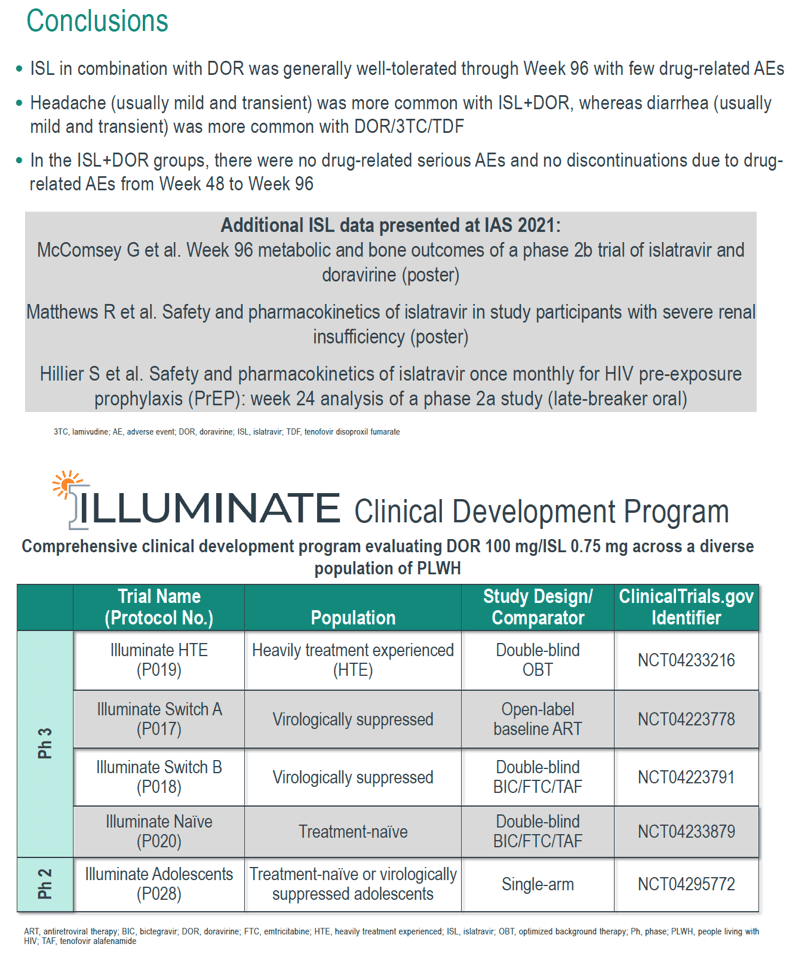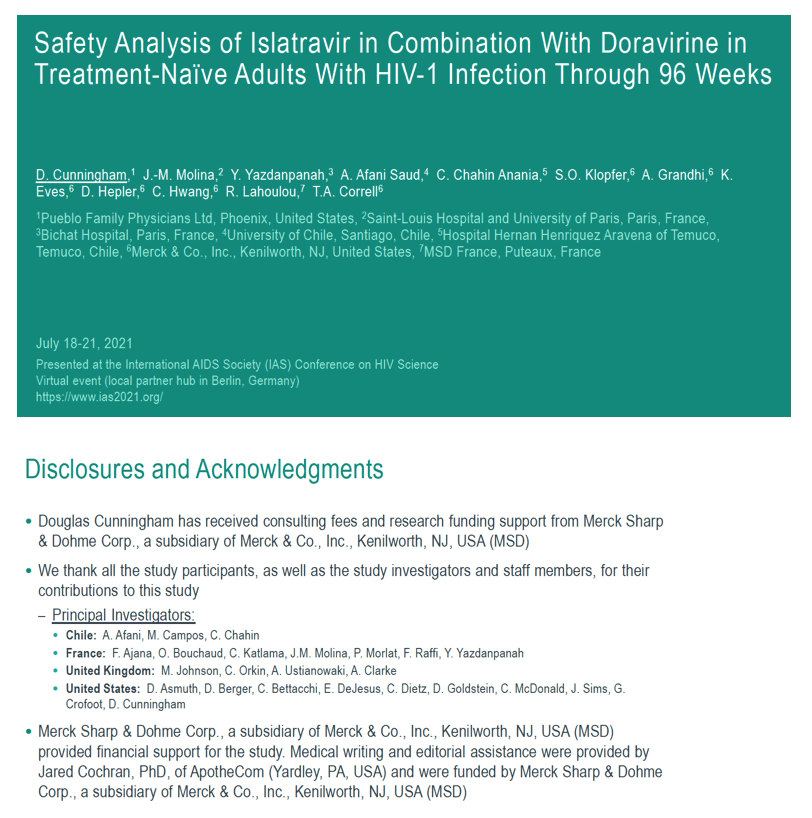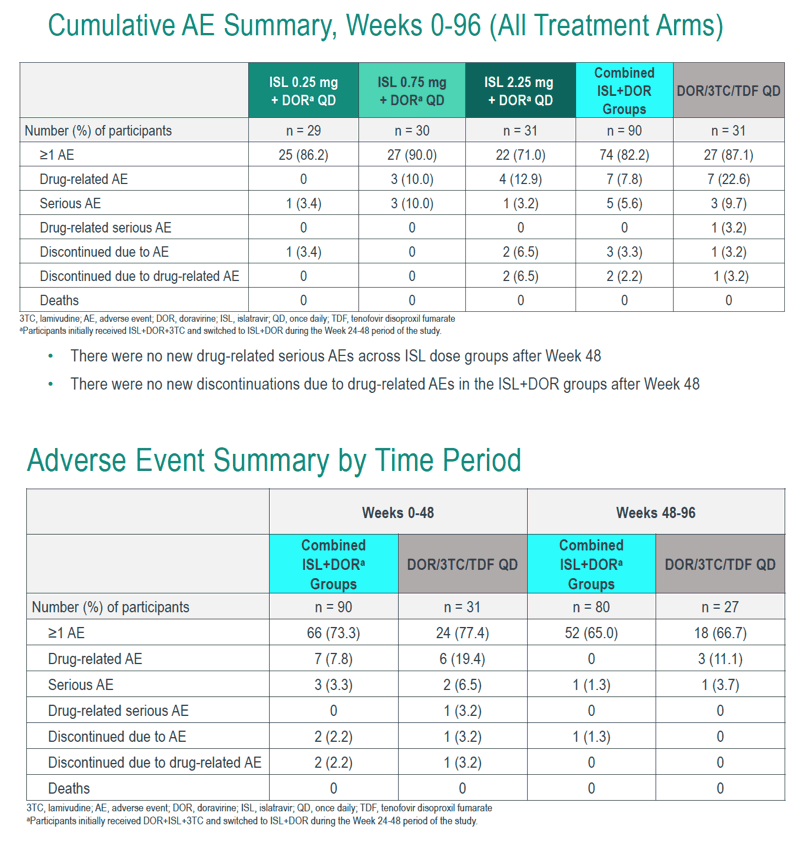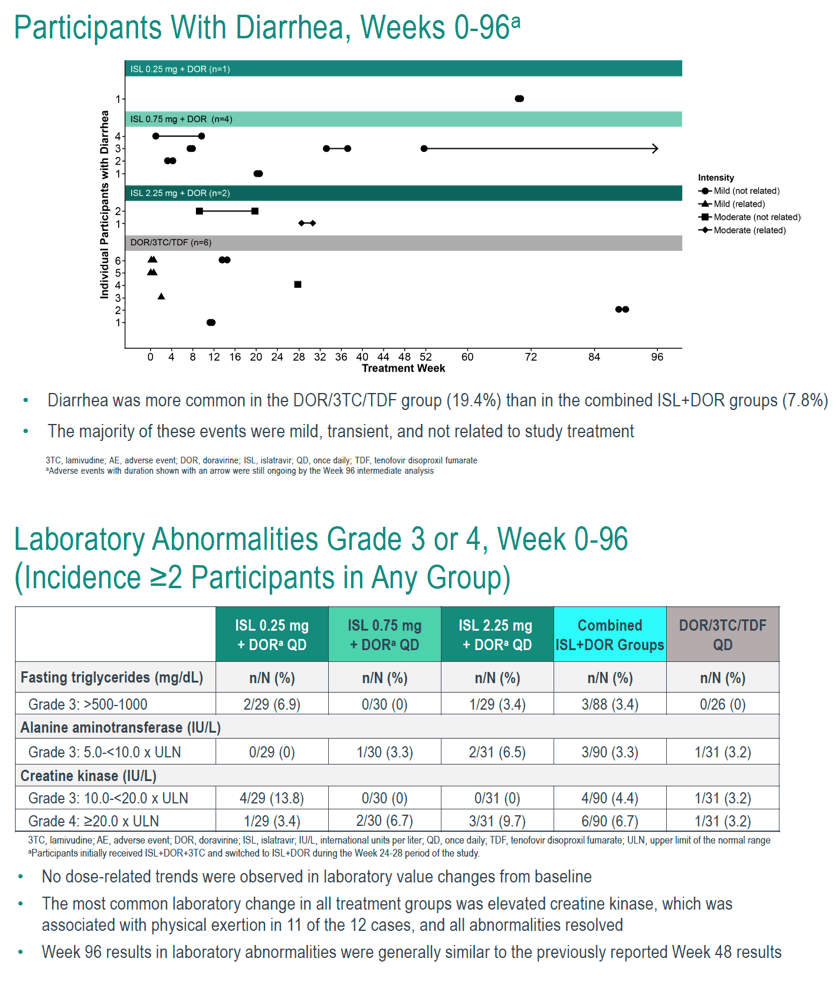 |
 |
 |
| |
Safety Analysis of Islatravir in Combination With Doravirine
in Treatment-Naïve Adults With HIV-1 Infection Through 96 Weeks
Islatravir/Doravirine Adverse Events Less
Frequent in Second Half of 96-Week Trial
|
| |
| |
IAS 2021, 11th IAS Conference on HIV Science, July 18-21, 2021
Mark Mascolini
People randomized to the novel antiretroviral islatravir plus the nonnucleoside doravirine had no drug-related adverse events and no withdrawals because of a drug-related adverse event in the second half of a 96-week phase 2 trial [1]. Merck is developing islatravir in combination with doravirine for antiretroviral-naive, virologically suppressed, and heavily pretreated people with HIV, including adolescents.
Islatravir, a nucleoside reverse transcriptase translocation inhibitor (NRTTI), has a unique dual mechanism against HIV replication: It inhibits two reverse transcription steps in the viral life cycle: translocation and chain termination [2].
MK-8591 protocol 011 enrolled antiretroviral-naive people with a viral load at or above 1000 copies, a CD4 count at or above 200, and no antiretroviral resistance. Researchers randomized 121 participants to one of three islatravir doses-0.25, 0.75, or 2.25 mg daily-plus doravirine and lamivudine (3TC) or to single-tablet doravirine/3TC/tenofovir disoproxil fumarate (TDF). Starting at week 20, people in an islatravir arm who reached a viral load below 50 copies dropped 3TC and continued just islatravir and doravirine. At week 60 everyone taking islatravir switched to the 0.75-mg dose.
Median age measured 28.5 years in the combined islatravir arms and 27.0 years in the doravirine/3TC/TDF arm. About 90% of study participants were men and about three quarters were white [3]. An FDA snapshot analysis at week 96 determined that 86.2% of participants randomized to 0.25 mg of islatravir, 90% randomized to 0.75 mg, 67.7% randomized to 2.25 mg, 81.1% in any islatravir arm, and 80.6% in the control doravirine/3TC/TDF arm had a viral load below 50 copies [3].
Through 96 week researchers recorded drug-related adverse events in no one randomized to 0.25 mg of islatravir, 10% randomized to 0.75 mg, 12.9% randomized to 2.25 mg, and 22.6% randomized to the control arm. No one randomized to islatravir had a drug-related serious adverse event at any point, compared to 3.2% in the control arm. Proportions who stopped treatment because of a drug-related adverse event were 0% randomized to 0.25 mg of islatravir, 0% in the 0.75-mg arm, 6.5% in the 2.25-mg arm, and 3.2% in the control arm. No one died in any study arm.
Next the investigators split the analysis into weeks 0-48 and weeks 48-96. Proportions with a drug-related adverse event were 7.8% in the combined islatravir/doravirine arms and 19.4% in the control arm in weeks 0-48, and 0% in the combined islatravir/doravirine arms and 11.1% in control arm in weeks 48-96. Respective proportions with a drug-related serious adverse event were 0%, 3.2% 0%, and 0%. Respective discontinuations because of an adverse event were 2.2%, 3.2%, 1.3%, and 0%. And respective discontinuations because of a drug-related adverse event were 2.2%, 3.2%, 0%, and 0%.
Headache emerged as the most common adverse event with islatravir/doravirine, while diarrhea proved most common with doravirine/3TC/TDF. Through 96 weeks headache emerged in 11.1% in the combined islatravir/doravirine arms versus 6.5% in the control doravirine/3TC/TDF arm. Most headaches were mild, transient, and not linked to treatment. Diarrhea was less frequent through 96 weeks in the combined islatravir/doravirine arms than in the control arm: 7.8% versus 19.4%. Most bouts of diarrhea were mild, transient, and not tied to study drugs.
The researchers spotted no dose-related trends in lab abnormalities through week 96. Grade 3 triglycerides (500 to 1000 mg/dL) were more frequent in the combined islatravir/doravirine arms than in the doravirine/3TC/TDF arm: 3.4% versus 0%. Grade 4 creatine kinase (20+ x upper limit of normal) was also more frequent in the combined islatravir/doravirine arms than in the control arm (6.7% versus 3.2%), but clinicians tied 11 of 12 jumps in creatine kinase to physical exertion.
The researchers concluded that these young trial participants tolerated islatravir plus doravirine well through 96 weeks, as few drug-related adverse events emerged. Phase 3 trials of 0.75 mg of islatravir with 100 mg of doravirine will evaluate the combination in heavily pretreated adults with HIV (Illuminate HTE, protocol P019), virologically suppressed adults (Illuminate Switch A, protocol P017; Illuminate Switch B, protocol P018), and previously untreated adults (Illuminate Naive, protocol P020). A phase 2 trial will study the same combination in naive or virologically suppressed adolescents.
References
1. Cunningham D, Molina JM, Yazdanpanah Y, et al. Islatravir safety analysis through week 96 from a phase 2 trial in treatment naive adults with HIV-1 infection. IAS 2021, 11th Conference on HIV Science, July 18-21, 2021. Abstract OAB0304.
2. Schurmann D, Rudd DJ, Zhang S, et al. Safety, pharmacokinetics, and antiretroviral activity of islatravir (ISL, MK-8591), a novel nucleoside reverse transcriptase translocation inhibitor, following single-dose administration to treatment-naive adults infected with HIV-1: an open-label, phase 1b, consecutive-panel trial. Lancet HIV;7:e164-e172. 2020. DOI: https://doi.org/10.1016/S2352-3018(20)30046-1
3. Molina J, Yazdanpanah Y, Afani Saud A, et al. Islatravir in combination with doravirine maintains HIV-1 viral suppression through 96 weeks. HIV Drug Therapy/Glasgow 2020, October 5-8, 2020. Abstract O415. https://www.natap.org/2020/GLASGOW/GLASGOW_35.htm






|
| |
|
 |
 |
|
|